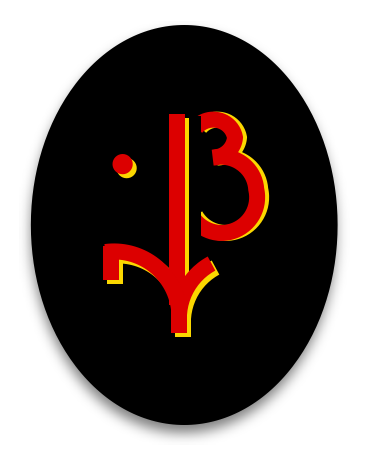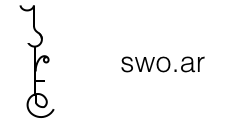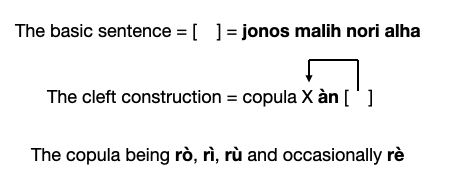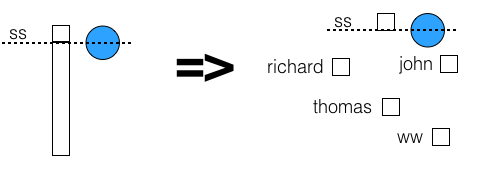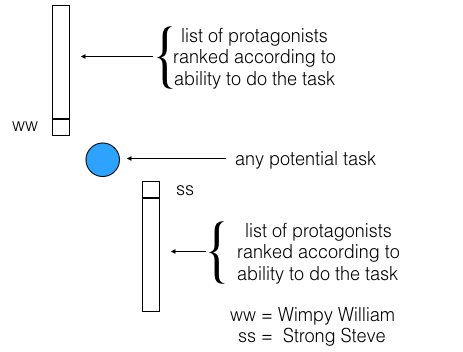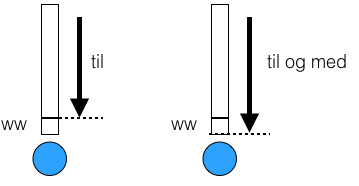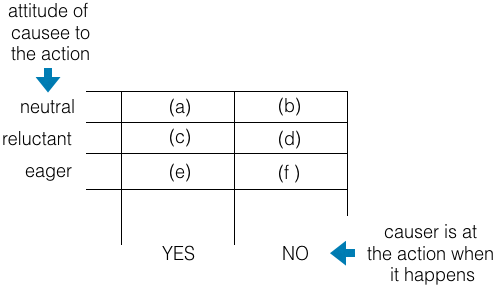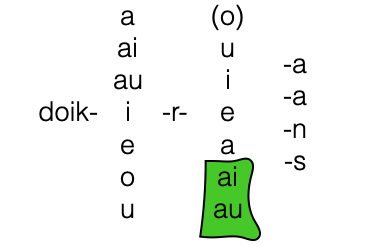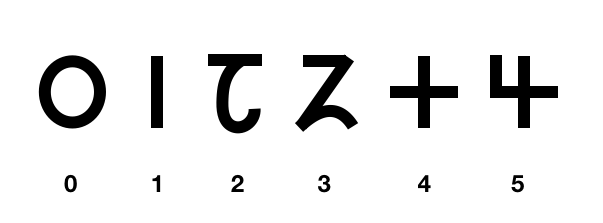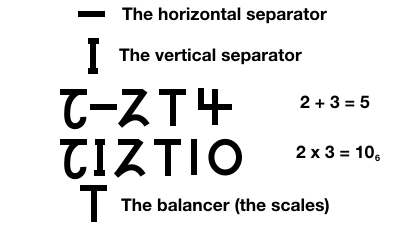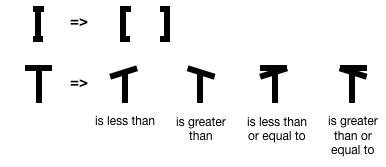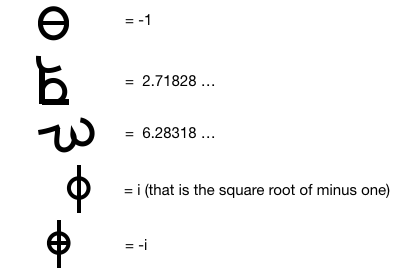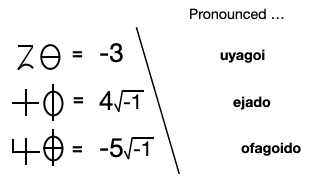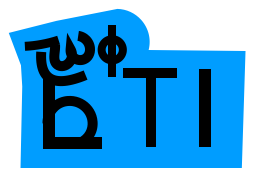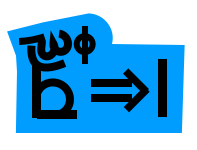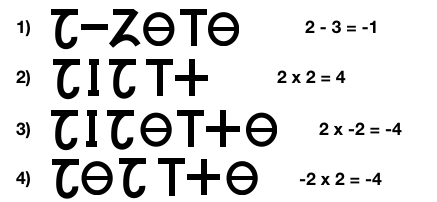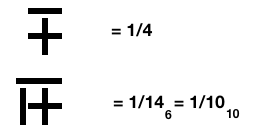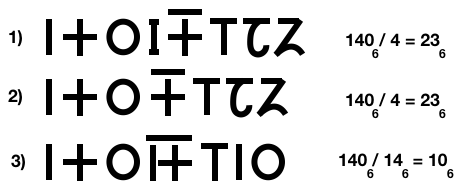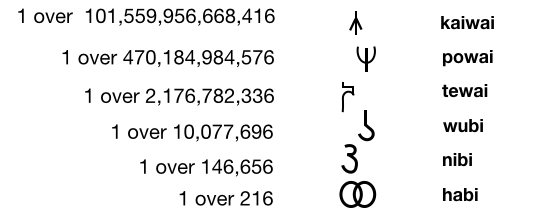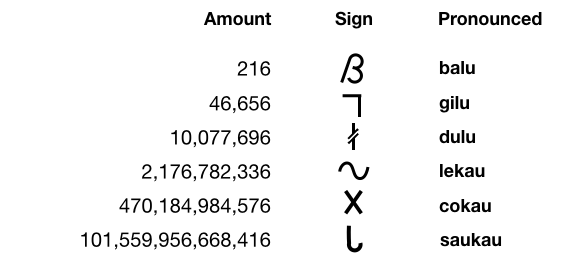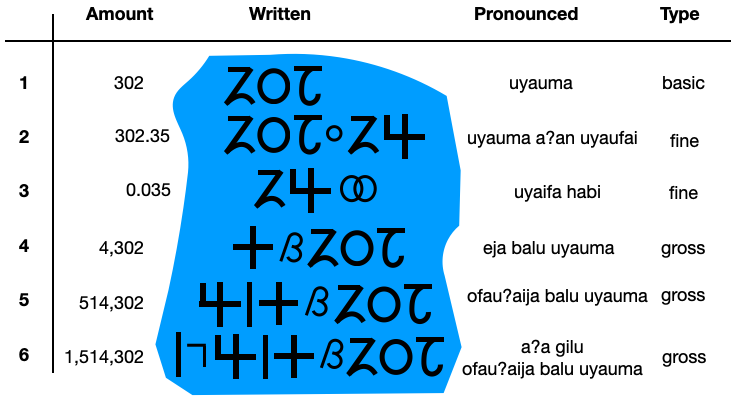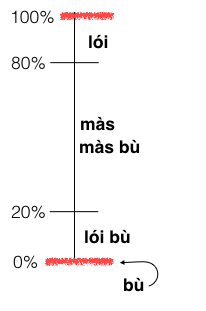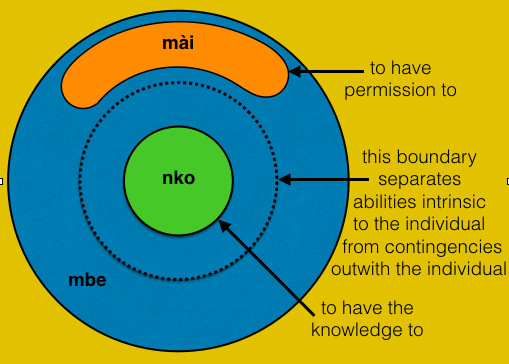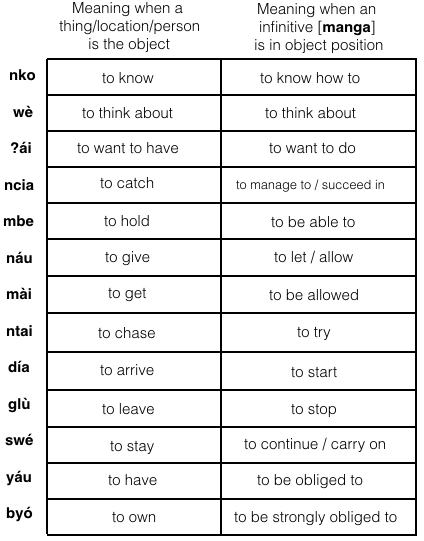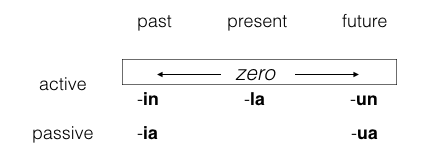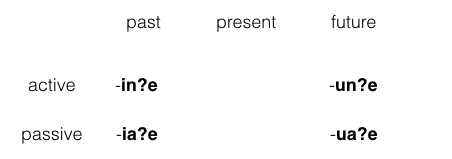Béu : Chapter 4 : Adjective
..... Adjectives
..
fé = ready/ripe/cooked : WUTUNG : "fey" pò = unready/raw
..
..... Short Verbs
..
In a previous lesson we saw that the first step for making an r-form is to delete the final vowel from the maŋga. However this is only applicable for multi-syllable words.
With monosyllabic verbs the rules are different. For monosyllabic verbs the r-form suffixes are simply added on at the end of the base.
swó = to fear ... swo.ar = I fear ... swo.ir = you fear ... swo.or = she fears ...
Many béu speakers pronounce a glottal stop between the two parts, especially if they are speaking forcefully.
In my transcription a dot is inserted between the base and the suffixes. In the béu writing system the two vowels are simple written alongside.
..
..
For a monosyllabic verb ending in ai or oi, the final i => y for the r-form.
gái = to ache, to be in pain ... gayar = I am in pain ... gayir = you are in pain ...
For a monosyllabic verb ending in au or eu, the final u => w for the r-form.
ʔáu = to take, to pick up ... ʔawar = I take ... ʔawir = you take ...
flài = to go for the first time, to venture
kléu = to argue, to disagree
dwái = to drive
blói = to move suddenly (maybe involuntarily)
cáu = to carry
dàu = to die
dwè = to store
tì = to touch, to contact => titi = to fondle
lí = to press => lili = to crowd, to throng => lilo = a crowd => liloweu = an omnibus => loweu = a bus
pyù = to ride
swó = to fear
sèu = to sow, to stitch
ntu = to cook
nje = rest, relax, take it easy
heca = to see
..
However 46 monosyllabic maŋga are exceptions : they pattern exactly the same as poly-syballic verbs.
..
| ʔái = to want | |||||||||
| mài = to get | myù = to come across | mbe = to hold | mpia = to lead | ||||||
| yáu = to have | |||||||||
| jò = to go | jwòi = undergo | ||||||||
| féu = to exit | fyá = to tell | flò = to eat | |||||||
| bái = to rise | byó = to own | blá = to say, speak | bwá = to call | ||||||
| gàu = to do | glù = to leave | gwói = to pass by | |||||||
| día = to arrive | dwái = to drive | ||||||||
| lài = to live | |||||||||
| cùa = to dislike | cwá = to cross | ||||||||
| sàu = to be | slài = to change | swé = to stay | |||||||
| kàu = to fall | kyò = to wait | klói = to like | kwè = to turn | ||||||
| pòi = to enter | pyá = to stop off | plòi = to use | |||||||
| té = to come | twá = to meet | ||||||||
| wè = to think | |||||||||
| náu = to give | nyáu = to follow | njua = to return | ngeu = to fly | nda = to put | ncia = to catch | nko = to know | ntai = to chase | ||
| háu = to learn |
..
The differences between ?ái "to want / to desire" and klói " to like / to be pleased with" .. 1) the former is more intense 2) when ?ái is used a change of state is envisaged : when klói is used we are talking about a steady state.
jwòi = to to pass through, undergo, to bear, to endure, to stand
glù = to leave / depart / stop : día = to arrive / to reach / to start ... glù dà = to leave / depart, glù gàu = to stop : día dà = to arrive / to reach, día gàu = to start
jwoida = a tunnel, gluda = a terminal, (end point of a transportation system pyada = a station (a get-on/get-off point on a transportation system) cwada = where you can change lines
swé = to stay, to live : yáu = to have on your person [for larger objects there is a connotation of "to have easy access to"]
For example ... pòr tìa = he/she enters the house ... not *poyor tìa
Note ... té "come" and jò "go" are Ø. However when the place being "gone to" or the place being "came from" are dían "here" or dèn "there" ... no dative mark (-n) is appended. Probably best to analyse this as a quirk of dían/dèn rather than té/jò being ambitransitive in any way.
The above are also among the most common verbs as well. If you are serious about learning béu you should try and memorize them as soon as possible.
..
..... Adjectives => Verbs
..
Some concepts that are coded as adjectives in English, are coded as verbs in béu. Usually they are body internal processes or states. So joining "to sleep", "to love", "to hate" (which are stative verbs in English) we have concepts like "to be angry", "to be jealous", "to be healthy" encoded as verbs in their base state.
[Note ... most of these are mental states]
Now in béu all multi-syllable adjectives become verbs simply by adding the verb train to them. For example ...
coga = wide
coguran komwe = it seems they have widened the road
However ... to make the corresponding maŋga you must add the suffix do. For example ...
cogako = to widen
For the few mono-syllabic adjectives that exist, this suffix must be present all the time. For example ...
àu = black
auko = to blacken
aukuran komwe = it seems they have blackened the road
Notice that these derived verbs are all transitive. To have the intransitive sense, you must use the verb tezau "become" along with the adjective.
..
..... 4 adjectives => verbs via derivation
..
| bòi | good |
| kéu | bad |
| fái | rich * |
| pàu | bland |
..
The adverbial forms for bòi and kéu are irregular. Instead of bòis and kéus we have bowe and kewe. Also bowe bowe => bravo bravo : kewe kewe => Booo Boo
..
The above 4 adjectives are usually applicable to an object or a situation. The affix -s (only applicable to these 4 adjectives) personalizes them ... also changes them into ɸ verbs ...
..
| boizari | I was healthy |
| keuzora | he is sick/ill |
| faiʒira | you are interested |
| pauzeru | you lot will be bored |
..
The first 2 refer to bodily state, the second 2 refer to mental state. The second 2 often have an object ... introduced by wò.
The manga forms are equivalent to nouns in English ...
..
| bòis | health |
| kéus | illness |
| fáis | attention/interest |
| pàus | boredom |
..
And we have 4 H verbs ...
..
| bòin | to be good for |
| kéun | to be bad for |
| fáin | to enrich, to develope |
| pàun | to tone down/stifle/dampen |
..
*"rich" in its non-monetary sense. If applied to food it means many flavours and/or textures. If applied to music it means there is polyphony. If applied to physical design it means baroque.
[Note to self : Sort this out : This appears in its subjunctive form as an expression often used when people are parting for what is expected to be some time. boiʒis => "may you be well" ]
..
... 12 adjectives which never appear as verbs
..
| junai | young |
| dweli | old (animate) |
| nofa | new |
| toki | right/correct |
| jebu | wrong |
| jini | clever, smart |
| tumu | stupid, thick |
| saba | north |
| uzaba | south |
| bene | right, positive |
| komo | left, negative |
| mauce | normal |
..
When nèu and mói are applied to rolls usually filled by humans, then they take the meanings "present" and "previous" respectively.
..
Of course you can always use a periphrastic expression if you wanted. For example ...
sàr tumu = I am stupid
tezar tumu = I become stupid
gàr tumu = I make (someone) stupid
..
dìa is what the sun does when it rises : cúa is what the sun does when it sets
These two are of interest for another reason ... dìa combines with día .. "to arrive" to make the word ... diadia .. "to happen". Also cúa combines with cùa .. "to depart" to make the word ... cuacua .. "to fade away".
Note that although the components going into these words have exactly opposite meanings, the compound words do not.
diadia appears in quite common expressions. For example ...
nén diadori = "what happened" ..... (nén r diadila = "what's happening" is not used for some reason)
..
... 12 adjectives => verbs with zero derivation
..
| boʒi | better | kegu | worse |
| faizai | richer | paugau | blander |
| saco | fast | gade | slow |
| hauʔe | beautiful | ʔaiho | ugly |
| ailia | neat | aulua | untidy |
| coga | wide | deza | narrow |
Note that the first two are irregular comparatives. The standard method for forming the comparative and superlative is ... ái = white : aige = whiter : aimo = whitest. ..
These adjectives directly become verbs. For example ...
| bozor | he improves | kegor | he worsens | boʒido | to improve | kegudo | to made worse |
| faizor | she develops | paugado | she runs down | faizado | to enrich/develope | paugado | to run down |
But notice that the base form of this derived verb has the affix "do".
..
... 38 adjectives => verbs with derivation
..
| ái | white | àu | black |
| hái | high | ʔàu | low |
| guboi | deep | sikeu | shallow |
| hò | long* | ʔé | short |
| seltia | bright | goljua | dim |
| taiti | tight | jauju | loose |
| jutu | big | tiji | small |
| felgi | hot | polzu | cold |
| naike | sharp | maubo | blunt |
| nucoi | wet | mideu | dry |
| wobua | heavy | yekia | light |
| pujia | thin | fitua | thick |
| yubau | strong | wikai | weak |
| fuje | soft | pito | hard |
| gelbu | rough | solki | smooth |
| ʔoica | clear | heuda | hazy |
| selce | sparce | goldo | dense |
| cadai | clean | dacau | dirty |
| igwa | elegant | uʒya | crude |
..
These adjectives do not become verbs directly, even as finite verbs (helgo form) they have the affix do.
| aikor | he whitens | aukor | he blackens | aiko | to whiten | auko | to blacken |
| haikor | she raises/rises | ʔaukor | she lowers | haiko | to raise | ʔauko | to lower |
So why do some verbs have ko in their finite form and others not. Well monosyllable adjectives always take ko. As for the rest, the ones that appear often as verbs, drop the ko in their finite form.
Notice that for multi syllable adjectives ending in a diphthong, the final vowel s dropped before appending ko.
..
However not quite all antonyms fall into the above pattern. For example ...
* Also means "tall" ... As in English, can also refer to time.
wazbia = far : wazbua or mùa = near : wazbi = distance : wazbai = about 3,680 mtr
..
..... The particles àn and gò
..
The particles àn and gò is used to introduce a clause where the clause is taking a syntactic position that can otherwise be filled by a noun. For example the object of nko "to know" can be a person or a location ...
..
jono nkar = I know John
london nkar = I know London
but it is also possible to know a fact ...
For example ... "I know that Jane is clever"
In English the word "that" is used for this function. However "that" has many other uses as well. àn and gò are the béu equivalents to "that" in the example above. Maybe it would be appropriate to call them "nominalizers". Both àn and gò have exactly the same function. However they differ in their position ... àn immediately precedes the complement clause and gò immediately follows the complement clause.
So ... "I know that Jane is clever" => nkar àn jene rò jini or jene rò jini gò nkar
Both these constructions are valid ... but which one to use ? Well, in a normal clause definite nouns come before the verb and indefinite ones follow. If you change "definite noun" => "old information" and "indefinite noun" => "new information" you get some idea whether to use gò or àn.
..
... The cleft construction
..
In English there is a construction used to shine special emphasis on one of the arguments. For example, you can modify the straight forward sentence ... "John gave Mary flowers" as ...
..
a) It was John that gave Mary flowers
b) It was Mary that John gave the flowers to
c) It was flowers that John gave (to) Mary
..
béu uses a very similar construction ... for the same purpose. For example ...
a) It was John that gave Mary flowers => rì jonos àn nori malih alha
b) It was Mary that John gave the flowers to => rì malih àn jonos nori alha
c) It was flowers that John gave (to) Mary => rì alha àn jonos malih nori
..
Notice that in the béu cleft construction, there is no need for a dummy pronoun like "it". Notice that the focused element keeps the pila?o which it has in the basic sentence.
[I guess I could have used nài instead of àn ... with the pila?o stuck on nài as in a normal relative clause construction]
..
... The optative construction
..
gò and àn usually don't occur utterance initial or utterance final ... they are tucked away, seperating the complement from the rest of the utterance.
However on occasion gò occurs at the end of an utterance. When this happens you have the optative voice. This form expresses a wish or hope of the speaker. But there is no appeal for the addressee to act. Also it is not really giving information as such. It is more about letting the speaker express his emotions [maybe "ventative would be a more suitable name for it ]
..
One of the most common occurrences of this construction is the benediction ... yiru fales gò "may you have peace"
..
Other examples are ...
yár halma gò = "I wish that I had an apple" = "if only I had an apple"
blàr doika gò = "Oh to be able to walk" = "If only I could walk" = "I wish that I could walk"
This form is used for both curses and benedictions ... curses being the more common ...
diablos òn ʔaworu gò = "May the Devil take him"
There are some formula type expressions that are used in certain situations/ rituals that use this form ... "God save the king" ?
..
... Evaluation construction
..
Now we have already talked about the copula in the last chapter. Here we carry on from there and discuss the construction that has a clause as one of the arguments of a copula.
In English you would say "It is good that John is hardworking".
Now the grammatically simpler version of this would be "That John is hardworking is good". However this arrangement is dispreferred. I would say that a major contribution to this dispreferment is that the complement is not clearly delineated from the rest of the sentence. In béu is delineation is always possible as we have a choice of complementizers ... we have a choice of syntax.
"It is good that John is hardworking" would be rendered jono rò koduʒi gò rò bòi with jono rò koduʒi gò being the complement clause.
| jono | rò | koduʒi | gò | rò | bòi |
|---|---|---|---|---|---|
| John | COP | hardworking | CMPZ | COP | good |
=> It is good that John is hardworking
With COP = copula : CMPZ = complementizer
..
Actually rò is usually dropped after gò. Also it is usually dropped after dí and dè. [rù being usually dropped after ndi and nde].
..
Often when discussing the advisability of some course of action a construction with an initial copula + one of the adjectives boʒi, neʒi or wái + gò are used. For example ...
..
| jubu | j-u-r-u | gò | sor-u | boʒi |
|---|---|---|---|---|
| nobody | go-3PL-IND-FUT | CMPZ | COP-FUT | optimum |
==> It will be best if/that nobody goes
..
| tìa-h | ny-e-r-u | jindi | gò | neʒi | |
|---|---|---|---|---|---|
| house-DAT | return-2PL-IND-FUT | now | CMPZ | necessary |
==> It is necessary that you (pl) will return to home now ==> You (pl) must go home right now
..
| sw-a-r | ifan | jindi | gò | jù | wái |
|---|---|---|---|---|---|
| speak-1SG-IND | anything | now | CMPZ | negative | appropriate |
==> It is inappropriate that I say anything now ==> I shouldn't say anything now
..
Usually boʒi/neʒi/wái is the new information so they come utterance final and are preceded by gò.
..
In the next chapter we will meet the two verbs yáu "to possess" and byó "to own" which, when used before a manga, add the meanings ""should" and "must" respectively to a clause. So by using yáu or byó you are can advise a course of action and depending on which auxilliary is use,can advise gentle or more forcefully.
Using the copula plus boʒi, neʒi or wái also allows you to advise a course of action This method is a bit more wordy and only giving one degree of forcefulness, but it does give you the following shades of meaning ...
..
boʒi = best ........................... this course of action will yield more benefits than some other course of action.
neʒi = necessary ................. this action is a vital part in some larger scheme.
wái = fitting/appropriate...... the action will be approved of by society.
..
Speculation as to the origin of gò. It is not a productive process but many nouns in béu were historically derived from verbs. For example ... solbe "to drink" versus solbo "a drink". It might be that gò was derived from gàu "to do" and once had a meaning like "action". If this is true then gò was co-opted to become a particle introducing clauses under the same circumstances as the Japanese word "koto" ....
..
| ano | hito-ga | hon-o | kai-ta | koto-ga | yoku | sirarete | iru |
|---|---|---|---|---|---|---|---|
| yon | person-NOM | book-ACC | write-ACC | CI-NOM | well | known | COP |
=> It is well known that that person wrote a book
..
With ... NOM = nominative : ACC = accusative : CI = clause introducer (in this case maybe it would be better to call this CT "clause terminator") : COP = copula
..
In Japanese "koto" as well as being a particle is also a noun meaning "affair" or "matter". However gò has long since lost it's nounhood (if indeed it ever was a noun)
..
(Note to self : sort out the below)
moze r neʒi laiwo = water is necessary for life
Note ... + neʒi = "a necessity and + boʒi = "the optimum"
..
..... 5 Particles
..
They are called Focus Particles in the Western Linguistic Tradition. They are certainly particles. But I am not so sure about the "focus" bit.
... yemua : whether
yemua <= kyema ... effect, aftermath, result
yemua means "whether" which means "there is a choice of two : it is immaterial which one is taken"
..
... ?au.e : only
..
?au.e <= a?a wè
This is a particles that take one element of a clause (usually a noun but could be an adjective or a verb) and links it more firmly to the background situation. For example ...
Consider "Steven can lift the rock" versus "Only Steven can lift the rock". "Only" brings into focus the fact that Steve has contemporaries ... also, via logic, that the others are weaker.
We can demonstrate this particle of a diagram similar to the diagram used in the previous section.
The RHS represents the situation as we represented the "even" situation. Actually the representation on the RHS is better as "only" does not bring to mind a range of protagonists rigidly lined up according to ability. Instead there is a weaker realisation that a disparate group of characters (might) exist besides the characters qualitied by "only".
This word precedes the word it qualifies.
..
... só ... truely a focus particle
..
só is a particle which serves to emphasize that which follows. It may thus correspond to emphatic inflection of the voice [ EIV ].
A particle like só is especially useful in a literate society. In English EIV is SOMETIMES represented with capitalization, sometimes with italics, but actually these methods are only used sporadically (I guess capitalization is ugly and/or is sometimes used for anger. I guess italics are tricky, a bit fiddly) a great pity ... many subtle jokes* can not be transcribed.
The above is the most pertinent reason for the existance of só. Rather a small unobtrusive particle than inventing a new font or whatever for transcribing EIV.
I know of two languages that have particles approximating to só ... Malay and Sanskrit ... "la" and "eva" respectively. Presumably "la" and "eva" are two words that are fully part of the spoken language and not just a device for showing EIV. Both follow the word they emphasize, while só goes before the word it emphasizes.
Below I give the six main uses for the particle ...
..
1) In English there is a construction used to shine special emphasis on one of the arguments. For example, you can modify the straight forward sentence ... "John gave Mary flowers" as ...
a) It was John that gave Mary flowers
b) It was Mary that John gave the flowers to
c) It was flowers that John gave (to) Mary
In béu the use of só would have the same affect. [In actual fact, béu has clefting constructions as well. See "The particles àn and gò" later on in this chapter (Is there any semantic difference between the two constructions?)]
..
2) The English construction above is usually called "clefting" or "left-dislocation". Clefting can be used to direct a question towards one argument. For example, from the straight forward question "Did John give Mary flowers"
a) Was it John that gave Mary flowers
b) Was it Mary that John gave the flowers to
c) Was it flowers that John gave (to) Mary
In béu the same affect would be achieved by putting só in front of the relevant item and sticking the particle "?" at the end of the utterance.
..
3) The third use of só is "corrections". For example if the statement jonos halma flori "John ate the apple" is known. But you want to correct it. You could say ...
a) só tomos halma flori "It was Thomas that ate the apple"
b) jonos só koizo flori "It was an orange that John ate"
Often the correction is doubly corrected by wiping out the bad element ...
a) só tomos halma flori_jù jonos "It was Thomas that ate the apple, not John"
b) jonos só koizo flori_jù halma "It was an orange that John ate, not an apple"
And sometimes the above is shortened to ...
a) só tomos_jù jonos "It was Thomas, not John"
b) só koizo_jù halma "It was an orange, not an apple"
So só and jù sort of form a partnership ... for inserting the correct and deleting the incorrect.
..
4) só is often followed by determiners. I don't know if this is a unique "use" but I am giving that pattern a separate entry here anyway. These 4 expressions are spoken in an angry voice quite often.
| só dí | "this one !" | só dè | "that one !" |
| só ndí | "these ones!" | só ndè | "those ones !" |
..
5) só can be used as a sort of vocative case ... not obligatory but can be used before a persons name when trying to get their attention. For example ...
só jene = Hey, Jane
só gì = Hey, you
There is an adjective intensifier sowe "very" ... no doubt related to the above. (or should that be sokai=> very : sowe => actually)
..
6) And lastly, só can be used for emphasis. Where other languages use EIV, béu uses só(but of course you can have só in addition to EIV)
In many situations só would be translated into English as "really", "just/only" or "very". Examples ...
ʃì r só totai => "she is only/just a child
talo onde r só bòi = "their boss is very/really good
..
*Another shortfall of the Western writing system is the lack of an accurate system for depicting pauses. In comedy, often everything is in the timing. béu has a superior system for representing pauses.
..
... holne : even
..
holne <= hó lé ní ... "to and at"
I find this one the most interesting of the five. All languages of the world has a word equivalent to "even". The provenance of these different words are varied and fascinating.
This is a particles that take one element of a clause (usually a noun but could be an adjective or a verb) and links it more firmly to the background situation. For example ...
Consider "Wimpy William can lift the rock" versus "Even wimpy William can lift the rock" ... "Even" adds the meaning ... "Wimpy William has a number of fellows and William is the weakest"
..
I find it best to think about this subject with the aid of diagrams. In the diagram below any protgonist above the potential task (blue disk) has the ability to do the task, the height above being proportional to their ability. And likewise, any protagonist below the blue disc lacks the ability to do the task, the distance down being proportional to this lack.
This diagram represents "Even wimpy William can lift that rock" (the positive case ... top left), and "Even strong Steve can not lift that rock" (the negative case ... bottom right)
In the positive case, the inclusion of "even" creates a range of people of varying abilities, over WW. In the negative case, the inclusion of "even" creates a range of people of varying abilities, under SS.
Note ... In English "Even strong Steve can not lift that rock" = "Not even strong Steve can not lift that rock". I guess "not even" should be recognized as a compound particle in English. béu does not allow this constuction.
..
The béu for "even" is the compound particle hó lé nì. This is actually a sort of calque on the Norwegian "til og med". See the diagram below.
"til og mid" means "to and with". An exact calque would be hó lé tú ... but béu has hó lé ní "to and at". The idea seems to be that you are moving down the range of people with varying abilities (thick black arrow) until you reach wimpy William "til", then you include wimpy William as well "til og med". As hó and ní are the forms that precede a noun, hó lé ní precedes the noun it qualifies. Also when it qualifies a verb it precedes said verb and when it qualifies an adjective it precedes said adjective.
..
[ Note to self : digress and talk about the origins of "jopa", "vieläpä", "hata fi", "zelfs" and even "even"]
..
... sole : also/as well
..
so le <= só lé
This is a particle that relies on a previous proposition.
For example "Thomas is strong".
Then if you say "Richard is strong also" ... you are actually slipping in a new element, giving it the same propositional value as a previously spoken element. Anaphora (or the memory of the previous proposition being uppermost in one's mind) is necessary for this particle to work.
In the above example "Richard" was slipped in beside "Thomas"
If you had said "Thomas is clever also", you would be slipping in "clever" in beside "strong".
sole = "also"
It can be slipped in almost anywhere in a sentence and it will be understood.
..
..... Family
..
Usually the words below are used to address members of your family (names are not usually used). All the words below have a special vocative case ... formed by prefixing a.
amama ... klogau dá = Mum, where are my shoes ?
..
There are 14 primary family relationships ...
..
| mother | mama |
| son | yaya |
| daughter | jaja |
| grand-daughter | fafa |
| father | baba |
| older sister | gaga |
| older brother | dada |
| grand-mother | caca |
| female cousin | saza |
| younger sister | kaka |
| grandson | papa |
| younger brother | tata |
| grandfather | wawa |
| male cousin | nana |
..
Below are 8 secondary family relationships.
..
| daba | uncle | the older brother of your father |
| taba | uncle | the younger brother of your father |
| gaba | aunt | the older sister of your father |
| kaba | aunt | the younger sister of your father |
| dama | uncle | the older brother of your mother |
| tama | uncle | the younger brother of your mother |
| gama | aunt | the older sister of your mother |
| kama | aunt | the younger sister of your mother |
..
And below are a further 8 secondary family relationships.
..
| yaja | offspring |
| maba | parents |
| cawa | grandparents |
| data | brothers |
| gaka | sisters |
| daga | elder syblings |
| taka | younger syblings |
| fapa | grandchildren |
..
There are two other family relations ... jwè = wife : jwò = husband ... jwà is an adjective meaning "by marriage" or "in-law". For example yaya jwà = son-in-law
It is worth mentioning that theae 32 words are all automatically taken as related to the speaker if no other possessor is mentioned. For example ...
data = my brothers : kaidata = brothers (in general) : data gì = your brothers ... note yó is never used for family members.
..
Note ... two other words follow the wife/husband pattern ... cewe = girl : cowo = boy
..
The more formal word for mother is macen. The more formal word for father is bacen.
..
..... Six causative constructions
..
"John made Jane drink the water" is an English causative construction ... [Note on terminology ... we call "John" the "causer" and "Jane" the "causee"]
..
In a similar manner to English ... béu uses gàu (meaning "to do" or "to make") as the neutral term for coding causation. For example ...
(a) jonos gore solbe moze jeneh = John made Jane drink water (earlier today)
..
| jono- | g-o-r-e | solbe | moze | jene-h |
|---|---|---|---|---|
| John-ERG | "do"-3SG-IND-PST | drink.INF | water | Jane-DAT |
..
Note that the causee gets the dative affix. Also note that base verb immediately follows gàu, the base verb object immediately follows base verb. The causee can come anywhere but the string solbe moze can not be broken. There are 3 possible places where jenen can appear.
And another example ...
jonos gore náu onyo waudoh jeneh = John made Jane give the bone to a dog (earlier today)
Notice that we have two datives in this construction. The string náu onyo waudoh can not be broken.
..
This construction implies that the causer was present when the event happened. We call it a "direct" causative construction.
There is another causative construction which doesn't imply the causer was present when the event took place. In fact it implies that the causer took some action which at a later time made the causee do what they did. The two actions very probably being linked by some sort societal connection (via other people).
(b) jonos gore àn jenes solbore moze = John had Jane drink water
The clause after àn ( i.e. jenes solbore moze ) has free word order.
The indirect causative construction is iconic ... separating the two verbs with àn reflects the separation of the two events ... both timewise and otherwise (i.e. there could have been a chain of protagonists involved).
..
There are 4 other causitive constructions in béu ... gàu is neutral as to how the causee views the action they are made to do.
If the causee is reluctant ... we use tumai "to squeeze" or "to press" instead of gáu.
If the causee is eager ... we use náu "to give" instead of gáu. For example ...
..
(c) jonos tumore solbe moze jeneh = "John made Jane drink water" or "John forced Jane to drink water (earlier today)"
(d) jonos tumori àn jenes solbore moze = "John had Jane drink water" or "John arranged that Jane had to drink the water" ... (the drinking occurred earlier today, the causing of the drinking ... yesterday or before)
(e) jonos nore solbe moze jeneh = "John let Jane drink the water (earlier today)"
(f) jonos nori àn jenes solbore moze = "John allowed Jane to drink water" or "John arranged for Jane to be able to drink water" ... (the drinking occurred earlier today, the arranging of the drinking ... yesterday or before)
..
Notice that in (a), (c) and (e) the base verb must occur [ Note to self : is this really necessary, maybe I should just not specify anything] immediately after gàu, tumai or náu. This is the same as the French, Italian or Spanish causative constuctions. Here is a French example ...
..
==> I will make Jean eat the cakesje ferai manger les gâteaux à Jean 1sgA make+fut+1sg eat+inf the cakes prep Jean
..
(a), (c) and (e) have what is called a compound causative verb. (i.e. one clause) ... (b), (d) and (f) are what are called periphrastic causative constructions. (i.e. two clauses)
..
It is possible for the indirect paraphrastic construction to give the embedded clause an impersonal form. For example ...
jonos gori àn solb-re moze = "John had the water drunk" or "John arranged for someone to drink the water" ................. [notice : no causee]
..
..
In the above table, it can be seen that there are 6 causative constructions. There are 3 degrees of "volition" (the willingness of the causee) and 2 degrees of "directness" (did the causer act directly on the causee or through intermidiaries).
..
It is possibly to chain causative constructions together. For example ...
..
jonos flònor jodoi = John feeds the animals.
g-r àn jonos flònor jodoi = It is arranged that John feeds the animals.
(ʃindes) gùr àn jonos flònOR jodoi = They arrange that John feeds the animals.
gauhu ondeh àn gùr àn jonos flòn jodoi = make them make John feed the animals.
by-r gàu ondeh àn gùr àn jonos flòn jodoi = it is necessary to make them make John feed the animals.
(gís) byír gàu ondeh àn gùr àn jonos flòn jodoi = you must make them make John feed the animals.
..
And 2 of these 3 causative verbs can be given impersonal forms ....
jenen g-ryə doika or g-ryə doika jenen = "Jane has been made to walk" or "somebody has make Jane walk
jenen tum-ryə doika or tum-ryə doika jenen = "Jane has been forced to walk" or "somebody has forced Jane to walk
Now náu "to give" is a strange word in that it never takes an impersonal form (see the section above). Instead the word mài "to receive/get" is used.
jene moryə doika = "Jane has been allowed to walk" ... [ as opposed to *jenen n-ryə doika ]
We will learn more about mài Ch 4.6 and Ch 4.7.
..
Another verb that we can mention here is penau meaning "to persuade, coax, convince, bring around, influence, sway"
penarua jene jonowo = "I intend to persuade Jane about John" = "I intend to bring Jane around to my way of thinking with respect to John"
(pás) penare jono jò tìah = "I got John to go home" = "I persuaded John to go home" .... [Note ... the maŋga does not immediately follow for penau ]
(pás) penare jono àn baba yor jò tìan = "I persuaded John that father should go home"
Also penau says nothing about the success of the action ... unlike the 3 other verbs we have considered where success is assumed.
..
..... More verb modifiers
We should get to know two more tenses now. These two tenses have to do with relative time. The five tenses we covered previously indicated absolute time.
..
..
The two additions are ai and au. Maybe call them the simultaneous tense and the consequential tense. The word for "the same" (adjective) in béu is ?ài. The ai tense is "the same time tense" ... a little tidbit to help you remember.
..
(pà) maumari_(gís) tìa pirai = I was asleep as you entered the house = I was asleep, when you entered the house.
When the ai is attached to the first verb of a clause couplet, it is equivalent to "when" in English.
(gís) tìa pirai_(pà) maumaru = When you enter the house, I will be asleep.
(gís) tìa pirai_(pà) maumari = When you entered the house, I was asleep.
..
The au tense tells you that the au-modified verb's action is consequential to the action entailed by the last verb mentioned. Often (in a narrative) the first tense sets the scene sometime in the past (the i tense) and subsequent actions are marked with the au tense. Quite long sections of narrative can be so marked.
..
It can be seen in WALS, that 45% of the world's languages have an imperfective/perfective distinction. [Note to self ... fully explore the rise and use of this distinction] Now I suspect that there is no real NEED for this distinction but it is a distinction that is easy to come about. The only real need that I can see for it, is to fit one action inside another. In béu this need is taken care of by the ai tense. Of course habituals are another thing the imperfective often covers. In béu these are taken care of, by the particles bolbo ans awa.
..
... The reciprocal construction
..
The reciprocal particle is bèn
jonos jenes timpur bèn = "John and Jane are hitting each other" = "John and Jane hit one and other"
Note ... lè "and" is not used when two nouns in the ergative case occur adjacent to each other.
The particle also comes after adjectives occasionally. For example ...
jono lè jene r ʔài bèn = John and Jane are the same.
No real reason why it should be added to the above sentence ... except that it is judged to sound good.
ʔáu bèn "to take mutually" is the béu expression meaning ... do the dirty deed, have relations, roger, root, shag, boink, slam the clam, thump thighs, pass the gravy, wet the willy, make the beast with two backs ... make love.
..
... Numbers
... Simple numbers
..
It can be said that base 216 is used. That is to say, there are 216 unique numbers.
Some of these numbers are given below ...
..
| value (base ten) ... | pronounced ... | value (base six) ... |
| 0 | jù | 0 |
| 3 | uya | 36 |
| 1510 | imaiya | 236 |
| 9010 | imauyai | 2306 |
| 19510 | ofaumaiya | 5236 |
| 18310 | ofauya | 5036 |
| 21510 | ofaufaifa | 5556 |
..
You do not have to worry about remembering 216 unique forms. You really only have to remember the table below ...
..
| 1006 = | a?au | 106 = | a?ai | one = | a?a |
| 2006 = | imau | 206 = | imai | two = | ima |
| 3006 = | uyau .... | 306 = | uyai .... | three = | uya |
| 4006 = | ejau | 406 = | ejai | four = | eja |
| 5006 = | ofau | 506 = | ofai | five = | ofa |
..
To construct a number ...
..
1) Select which elements you need. For example, for 5436, you will need the elements ofau + ejai + uya
2) If the element is non-initial, delete the initial vowel of the element => ofau + jai + ya
3) Join up the elements => ofaujaiya
..
Now in a block of text, a number would be just written as any other word would be. However sometimes you come across "blue space". This is an area (of paper, or screen ... whatever) that is specially for manipulating numbers and mathematical expressions. In a "blue space" a number is a composite figure. Made up from up to three of these six symbols below ...
..
For example, here is 5436. 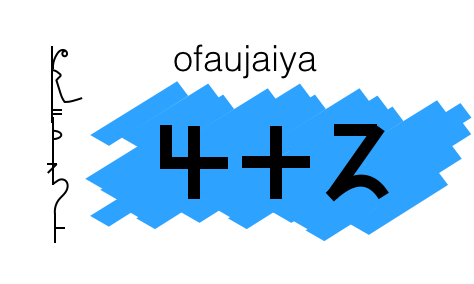 On the left is how it would appear in a text block. On the right is how it would appear in "blue space".
On the left is how it would appear in a text block. On the right is how it would appear in "blue space".
As you can see, in "blue space" the numbers stand beside each other horizontally. One step to the left giving a one order of magnitude boost. In "white space" as you go down you go forward in time.
..
..
..
The heart of the arithmetic system is the two separator signs and the balancer sign. The balancer mark is simply an equal's sign. The two separator signs govern addition and multiplication. It is understood that when two numbers occupy the same horizontal slot but are not touching, they should be added. The horizontal separator is considered to separate two numbers in such a way that they are not touching.
It is understood that when to numbers occupy the same horizontal slot but are touching, they should be multiplied. The vertical separator is considered to separate two numbers in such a way that they are touching.
The second two of these signs give rise to some secondary signs. These are shown below ...
The vertical separator gives rise to brackets, used in a similar way to brackets in the WMT.
And now for five more signs ...
Which lets me display ...
..
The most beautiful equation ever. A version of Euler's identity. The most beatiful version, especially when expressed in my gorgeous script. You can see that raising to a power is done in a similar way to the WMT. Except the power is slightly larger (half size) and positioned more centrally.
The above is also Euler's identity. béu has two signs for addition. I use the second one when I am feeling dynamic ;-)
..
And now for addition and multiplication involving a minus number ...
The signs for “-1”, “i” and “-i” always come after the numerals.
In (1), notice that only one symbol needed for “-1” ... as opposed to the two symbols needed in the WMT ... "-" and "1". In (4), notice that the vertical separator is dropped.
We can say that subtraction does not really exist. We only have addition involving negative numbers. For addition you always need the horizontal separator.
The above is -3 x 2 … not -3+2
Reciprocals are represented by putting the number under a bar.
We can say that division does not really exist. We only have multiplication involving a reciprocal ...
In (1) we see division (multiplication of reciprocal) with a vertical separator. (2) we can see the exact same equation with the separator dropped … the bar/non-bar transition stops the two numbers running into each other. In fact the vertical separator is invariably dropped if possible.
..
... Accuracy
..
The above 6 symbols are mostly to do with numeric accuracy.
The first one is a vertical half-height line, positioned centrally. It is pronounced du and means "exactly".
The second is pronounced te and can be suffixed to either a number or a magnitude word. It means "around about".
The third is pronounced ma and can be suffixed to a number. If for example, it was suffixed to 3.14 the resulting construction would mean "an amount between 3.14 and 3.15.
The fourth one is rarely used. It is the opposite of ma and pronounced go. If suffixed to 3.15 it would mean "an amount between 3.14 and 3.15.
The last two are stand-alone words ...
The fifth is pronounced ??. It signifies a repeating sequence. For example 1/7 would be 0.14857Ҵ5 with the tail-end 5 meaning that the last five figures before the symbol are to be repeated.
The sixth is pronounce mago and means "plus or minus". It is followed by the number that represents the uncertainty.
..
... Extended numbers
..
Earlier I said that there were only 216 numbers. This is true, there are only 216 basic numbers.
To extend the number range we can add magnitude words. There are 12 of these ...
..
..
Any number over 5556 is called a gross number. Any number containing a part smaller than one is called a fine number.
..
OK. So lets take it to the next level ...
| 5556 | ofaufaifa | 21510 |
| 10006 | a?a balu | 21610 |
| 10016 | a?a balu a?a | 21710 |
| 10026 | a?a balu ima | 21810 |
| 10036 | a?a balu uya | 21910 |
... and so on ...
..
If you remember from the section kenʒi in CH2, numbers come after the head of the NP which they qualify (and when I say numbers, I mean an amount between zero and 215 ) ... numbers go into slot 2 of the 5 NP slots. However numbers that qualify a magnitude word come before the magnitude word (this is the same as English and most major European languages)
..
When rendering a number with a large dynamic range, usually you just mention the biggest magnitude word. For example …
ima dulu ofaujaiya ejauyaima uyaumai?a = 2,543,432,3216
Although it is not against the rules to say …
ima dulu ofaujaiya gilu ejauyaima balu uyaumai?a
But why would you want to ?
If any magnitude words are dropped, two dots are inserted as place holder in "blue space". No such place holders are necessary in "white space".
..
Remember that if any “number” is missing, you insert jù (zero).
..
Now what do you do if you want to modify a noun by 21610 or more. Well we must then use the partitive particle wì. You could say it is equivalent to “of” but it has only one job. English “of” has 5 or 6 jobs at least. It is used for “zooming in” … used in such expressions as “five out of six doctor”/“five of the six doctors”. In béu this would be ofa wì moltai a?ai. Now wì must also be used every time you have a magnitude word. So in béu “43210 doctors” = ima balu wì moltai
..
Here are some extended numbers ...
..
..
In example (2) above, note a?an. This means "unit". You can consider it as equivalent to the WMT decimal point. a?an is not actually a magnitude, more a dimensionless dimension if you will. Dimensions will be explained later.
In example (6), balu would normally not be pronounced. Also its symbol (a sort of BETA symbol) would normally not be written, a space would suffice.
There is a little bit of flexibility with the system. Fir instance, examples (2) and (3) can be rendered ...
..
Addendum ...
a?amau = "two and up" imamau = "three and up" uyamau = "four and up" ejamau = "five and up" ofamau = "six and up" a?aimau = "seven and up"
HOW ARE - "i" "-i" PRONOUNCES. AN EXAMPLE SHOWING THAT THESE COME AFTER MAG. WORD.
a?aigoi = "five or under" ofagoi "four or under" ejagoi = "three or under" uyagoi = "two or under" imagoi = "one or under"
..
... Likelihood and possibility
..
The béu method of expressing "likelihood" has been given already in Ch3.10. Two particles are used ... màs and lói. Pretty straightforward.
más is used against a back ground that no event will occur. más bù is used against a back ground that an event will occur.
..
In the below chart, all things that are possible are blue. If there is nothing standing in the way of a person doing something, the verb mbe is used as an auxiliary to express this.
mbar jò tìan "I can go home". If one wants to be more specific, one can use nko or mài. nko means that the individual has the knowledge to carry out the task, mài means that the individual is allowed to carry out the task. Originally mbe meant that the individual had the bodily strength to carry out the task. However these days it indicates that the individual can carry out the task (for whatever reason).
The above three words also serve as normal verbs as well ... transitive verbs that can take a noun as an object. nkar jono = I know John ... maryə toilia = I got some books ... mbara toili = I am holding a book
mbe when followed by a noun has the meaning "hold in your hand" ... the idea is that when you hold something in your hand, you have total mastery over it. I extended the meaning and when mbe is followed by a verb it takes the meaning "root possibility".
Note ... in English "must" has two distinct functions. It codes "obligation" as in "You must visit your Mother" and it codes a "sort of likelihood" as in "You must be hungry". The last one means 100% certainty but it is also a bit like a question. It is expected/hoped that the 2nd person will reply in the affirnative. Also what is asserted has been "assembled" by the 1st person from diverse clues/facts. For instance ... (1) The first person has just got off a train ... (2) It was a long journey ... (3) The train was delayed in the middle of nowhere by an additional 5 hours ... (4) There was no buffet car on the train ... (5) There were no stops apart for alighting passengers.
If the 2nd person answers in the affirmative, the 1st person will be a bit chuffed. He is a bit Sherlock-Holmes-like.
In béu, the equivalent of "must" (byó) only has the "obligation" function. For the other function you would append the -n evidential to the verb. Also perhaps you would add the YES/NO question particle  to the end of the utterance. In the chart about the diachronic developement of the modal verbs I have not included this "sort of likelihood" function. If I had I would have given it its own circle.
to the end of the utterance. In the chart about the diachronic developement of the modal verbs I have not included this "sort of likelihood" function. If I had I would have given it its own circle.
..
... 13 Key Verbs
..
The 13 verbs given below carry quite a heavy workload. Notice that there English translation varies depending on whether a noun / NP is the object or an infinitive is the object.
..
..
jenes nkor laigau = Jane knows calculus : jenes nkor london = Jane knows London : jenes nkor tomo = Jane knows Thomas
jenes nkor kludau = Jane knows how to write : jonos nkor bunda tìa = John knows how to build a house
This verb can also take a complement clause [ CC ] that represents a fact. [nkar gò jene r jini = I know that Jane is clever]
..
jenes wora laigau = Jane is thinking about calculus : jenes wora london = Jane is thinking about London : jenes wora tomo = Jane is thinking about Thomas
jenes wora kludau = Jane is thinking about writing
This verb can also take a complement clause [ CC ] that represents a fact. [wàr gò jene r jini = I think that Jane is clever] [Note to self ... steady state/dynamic ... wara ...]
..
jaja ʔór fanfita = My daughter wants a pony
jaja ʔór jò tìan = My daughter wants to go home
This verb can also take a complement clause [ CC ] that represents a fact. [jaja ʔór gò kaka jò tìan = My daughter wants her younger sister to go home]
..
waudos yanfa ncoryə = The dog has caught the hare
ncari bunda tìa = I managed to build a house : jonos nùa ncori ncia = John succeeded in catching the mouse
..
mbara biabia = I've got a butterfly in my hand
mbar bunda tìa = I can build a house
..
ós pàn nore toilia = He gave some books to me (earlier on today)
ós pàn nore jò tìan = He let me go home = He allowed me to go home
..
mari toilia = I received some books : mari toilia nufi = I got some books from them
màur jò tìan jé idai = We are allowed to go home at 4 o'clock = We have permission to go home at 4 o'clock
[Note ... the meaning of mài with a maŋga means the same as the passive of náu with a maŋga ... màur jò tìan jé idai = nər manun jò tìan jé idai]
..
waudos yanfa ntora = The dog is running after the hare = The dog is chasing the hare = The dog is pursuing the hare
waudos yanfa ntora ncia = The dog is trying to catch the hare = The dog is attemping to catch the hare
..
jonos dori tìa jé ezai = John arrived home at ten o'clock (at night) = John reached home at ten o'clock
jonos dori solbe beda léu dinda = John started to drink three days ago
jonos doru kodai koca léu dinda = John will start working in three days time.
jonos dorua kodai koca léu dinda = John intends to start working in three days time.
weuno dori doika = the engine started .... note that the verb doika "to walk" or "to operate" is necessary here
..
jenes glore tìa goize = Jane left home in the morning : ngeunos glore london goize = The aeroplane departed London this morning
jenes glore kodai jé idai = Jane stopped work at 4 o'clock (in the afternoon)
..
jonos swór london = John stays in London
jonos swór doika tìan = John keeps on walking home = John continues to walk home
..
jonos yora toili = John has a book (on him)
jonos yora jò tìan = John should go home
..
jonos byór fanfa = John owns a horse
jonos byora jò tunheun = John must go to the townhall
..
..
This is a 2 place verb. Well the recipient is in the dative, so that doesn't count towards the valancy ... right ? But unlike mài ... this one sort of needs a dative to make sense.
*jonos nore jò tìan pàn = ... béu does not like the dative separated from the verb by a two-word object ... well not when the dative is one-word anyway.
This verb can also take a complement clause [ CC ] introduced by gò.
ós pàn nore gò jonos bù yora jò haundan kuzaza = He told me that Johnny doesn't have to go to school tomorrow
..
..
This verb can also take a complement clause [ CC ] ... again introduced by gò. This can happen in the situation where you are responsible for someone else (usually an offspring) and someone in authority has given permission (via you) for your offspring to do something (or not do something). For example ...
maryə gò jonos bù yora jò haundan kuzaza = I have been told that Johnny doesn't have to go to school tomorrow
..
Below is a summary of what type of object these verbs can have ...
..
Notice that when one of these words takes a maŋga, the maŋga must immediately follow. As usual, if the maŋga has an object it must immediately follow the maŋga. For all these twelve verbs, the maŋga has no subject ... or the subject is the same as the main verb.
In English usage (in fact all the Germanic languages) ... the way to negate modal words is a confusing. Consider "She can not talk". Since the modal is negated by putting "not" after it and the main verb is negated by putting "not" in front of it, this could either mean ...
(a) She doesn't have the ability to talk "or" (b) She has the ability to not talk
Note ... Only when the meaning is (a) can the proposition be contracted to "she can't talk". In fact, when the meaning is (b), usually extra emphasis must be put on the "not". (a) is the usual interpretation of "She can not talk" and if you wanted to express (b) you would rephrase it to "She can keep silent". This rephrasing is quite often necessary in English when you have a modal and a negative main verb to express.
In béu it is possible to negate the active verb and to negate the maŋga separately. The maŋga negator is jù. This is the same negator used for nouns. It only has scope over the NP following it (unlike bù which has scope over the whole clause). For example ...
jenes bù blòr flò coko => Jane can't eat chocolates (Jane lacks the ability to eat chocolates) ... for example she is a diabetic and can not eat anything sweet.
jenes mbor jù flò coko => Jane can not eat chocolates (Jane have the ability not to eat chocolates)... meaning she has the willpower to resist them.
jenes bù mbor jù flò coko => Jane can not not eat chocolates (Jane lacks the ability, not to eat chocolates) ... meaning she can't resist them.
And another example ...
(jés) bù byér flòn jodoi = You lot don't have to feed the animals
(jés) byér jù flòn jodoi = You lot mustn't feed the animals ... (this is for a general/timeless situation ... kyà flòn jodoi would be used for a "here and now" situation)
(jés) bù byér jù flòn jodoi = You lot can feed the animals if you want
Thought verbs
..
Now it seems that the majority of languages have at least one way of bracketing off the META-DATA from DATA. English has two types of complement clause (CC from now on) ... one introduced by the complementizer "that" and the other introduced by a question word. These usually take the place usually taken by an O argument. béu has one CC which is introduced by the particle gò. Some of the thought-verbs that can take either a CC or an O argument are listed below ...
petika "to select/choose/pick/decide" : glù "to know" : wè "to be thinking about/consider/ponder" : celba "to remember" : dolka "to forget" : wespila "to understand" : glùn "to inform/tell" : celban "to remind" ... etc. etc.
béu does not have indirect speech as English has ... i.e. John said (that) that was stupid. In béu this would have to be framed as direct speech ... i.e. "this is stupid" said John (notice the change of reference for time and argument). Also ... "John asked whether I wanted to go" would be recast as "John asked "you want to go ?" "
The béu CC is exclusively used for thought-verbs ( IS THERE AN EXCEPTION TO THIS ?? )
R.M.W.Dixon divided verbs into two types : Primary Verbs and Secondary Verbs. He further divides the former into two types.
Primary A : all arguments must be NPs or pronouns Primary B : all arguments must be NPs or pronouns but one argument can alternatively be a complement clause
Secondary : does not take a NPs or pronouns argument but modifies another verb.
Dixon divides the Secondary Verbs into three types according to meaning. Below I show these three types along with examples from English ...
Secondary A : can, should, must, start, continue, stop Secondary B : want, wish (for), intend, pretend Secondary C : make, cause, force. let, help
Now Dixon's classification can be argued about. But here I just want to say ... in béu I have tried to make Dixon's Secondary Concepts expressable by Primary verbs. I feel this is justified in that all Secondary Verbs must be derived from simpler Primary Verbs back in the mists of prehistory.
mbe can also take a complement clause [ CC ] that represents a fact. This CC has the complementizer gò. In this situation it is equivalent to the "believe"
mbar gò jene r jini = I believe that Jane is clever ..
.
... To what degree
..
There is a noun sù meaning "level*". This word combines with three pila?oi to produce three very usefull words that express "to what degree" ...
sùn = enough : sumau = too : sugoi = not enough
Often these words directly follow in adjective. When the direstly follow a verb they are qualifying the verb (hence qualifying the clause as a whole)
They can be moved from their position directly behind the verb and in the forms sunis, sumaus and sugois qualifying the clause as a whole.
When it the adjective slot of a NP they are understood to be referring to the "amount" or "quantity" of the noun.
* sù is used when something is perfectly level ... for instance sù moze "water level". lauja is used when not perfectly level ... for instance a "storey" would be called lauja.
..
... The participles
..
It can be said that there are ten participles in béu. A participle basically turns a clause into an adjective phrase, so they are popularly used for their succinctness.
The first 6 are listed below ...
..
1) The first participle turns a clause with aortist tense into an adjective phrase.
..
| báu | nài | fl-o-r | halma | => | báu | flò | halma | |
|---|---|---|---|---|---|---|---|---|
| the man | REL | eat-3SG-IND | apples |
The man who eats apples
..
There isn't really a good English equivalent to báu flò halma so I have left it out. Notice that flò is the base form. So the '"active aortist participle" is exactly the same as the base form of the verb. In other words it is a zero derivation process.
Woman studying University : Barking dog (a dog inclined to bark)
..
2) The second participle turns a clause with present tense into an adjective phrase. -la is the form it takes.
..
| báu | nài | fl-o-r-a | halma | => | báu | flo-la | halma | |
|---|---|---|---|---|---|---|---|---|
| the man | REL | eat-3SG-IND-PRES | apples | => | báu | eat-PRESENT.ACTIVE.PRTCPL | halma |
................ The man who is eating apples => The man eating apples
Family visiting sauna : Barking dog (a dog barking right now) : The dancing woman : The flashing light : The winding road : The playing boy
..
0) As can be seen in the table above, there is a gap in the system, no form for present passive participle. However this gap can be filled in using paraphrastic constructions involving jwòi "to undergo".
| halma | nài | jw-o-r-a | flò | => | halma | jwo-la | flò | |
|---|---|---|---|---|---|---|---|---|
| the apple | REL | undergo-3SG-IND-PRES | eat | => | the apple | undergo-PRESENT.ACTIVE.PRTCPL | eat |
................ The apple that is being eaten => The apple being eaten
..
3) The third participle turns a clause with past tense into an adjective phrase . -in is the form it takes.
..
| báu | nài | fl-o-r-i | halma | => | báu | flo-in | halma | |
|---|---|---|---|---|---|---|---|---|
| the man | REL | eat-3SG-IND-PAST | apples | => | báu | eat-PAST.ACTIVE.PRTCPL | halma |
The man that ate an apple
| báu | nài | r | flo-in | halma | => | báu | flo-in | halma | |
|---|---|---|---|---|---|---|---|---|---|
| the man | REL | COP | eat-PAST.ACTIVE.PRTCPL | apples | => | báu | eat-PAST.ACTIVE.PRTCPL | halma |
The man that has eaten an apple
| báu | nài | ri | flo-in | halma | => | báu | flo-in | halma | |
|---|---|---|---|---|---|---|---|---|---|
| the man | REL | COP.PAST | eat-PAST.ACTIVE.PRTCPL | apples | => | báu | eat-PAST.ACTIVE.PRTCPL | halma |
The man that had eaten an apple
..
There isn't really a good English equivalent to báu flo.in halma so I have left it out.
..
Tired boy : The name of the woman who came here yesterday is Hanna
(3) + (4) both have current relevance. (3) that the state resulting from the action holds at the time os speaking. (4) that the intention that will /should result in some action is currently in somebodies mind.
..
4) The fourth participle turns a clause with future tense into an adjective phrase . -un is the form it takes.
..
(Does it mean "intend" or just "future" ... what about the tense forms -u and -ua) ?? Intention is implied : this mirrors (6) where obligation is implied.
..
5) The fifth participle turns a clause with past tense into an adjective phrase. It is the undergoer that is qualified by this participle. -ia is the form it takes.
| klimitu | laud-ia | |
|---|---|---|
| cutlery | wash- PAST.PASSIVE.PRTCPL |
=> the washed cutlery
..
6) The sixth participle turns a clause with future tense into an adjective phrase. It is the undergoer that is qualified by this participle. -ua is the form it takes.
..
| klimitu | laud-ua | |
|---|---|---|
| cutlery | wash- FUT.PASSIVE.PRTCPL |
=> the cutlery to be washed
..
We said at the start that béu has 10 participles. The remaining 4 are just slightly modified versions of participles (3), (4), (5) and (6). They mean exactly the same as their counterparts above, but with immediateness of time added.
..
Hence kludin?e = (have) just written : kludun?e = just about to write : kludia?e = just been written : kludua?e = just about to be written
..
The copula takes all these 10 participles as well ...
jwè junai = young wife : jwè dweli = old wife : jwè or jwè saula* = present/current wife : jwè sau.in = previous/former/ex wife : jwè sau.un = wife-to-be
[ Note to self : does jwè mean wife and jwò mean husband ?]
*Note ... because sàu is a monosyllable, it is not reduced to *sala as kludala is.
..
THE BELOW SEEMS OK. IT ALL SHOULD BE INTEGRATED
..
In the manga section, I introduced 3 participles (adjectives derived from verbs). Here I will introduce 2 more.
The past participle (occasionally called the passive participle) is formed by affixing -ia to the verb base. The future participle (occasionally called the obligation participle) is formed by affixing -ua to the verb base. The original vowels from the base being deleted.
..
| Verb | Adjective | Noun | Noun |
| ============== | ============== | ============== | ============== |
| laudo | laudia | laudia | + laudia |
| to wash/launder | laundered | laundered clothes | a laundered item |
| kuwai laudia | k+ laudia | ||
| ============== | ============== | ============== | ============== |
| laudua | laudua | + laudua | |
| to be laundered | laundry | a soiled item | |
| kuwai laudua | k+ laudua | ||
| ============== | ============== | ============== | ============== |
..
Notice that laudia and laudua can be both an adjectives and a noun. This is common in languages, why make a differentiation if there is no ambiguity. For instance, in English you can say "sky blue is a really dreamy colour". Now here "sky blue" is CS (copula subject), usually the preserve of nouns. But we don't say "the blueness of the sky ..." . We like to keep it short, especially when no ambiguity threatens.
However if there is a need to disambiguate, the particle kuwai or the prefix k+- can be employed.
kuwai laudia = the state of being washed : k+ laudia = all the washed things (I guess theoretically this word has a universal meaning ... but in practice the meaning only applies locally)
..
| Verb | Adjective | Noun | Noun |
| ============== | ============== | ============== | ============== |
| kludau | kludia | kludia | + kludia |
| to write | written | notes | a note |
| kuwai kludia | k+ kludia | ||
| ============== | ============== | ============== | ============== |
| kludua | kludua | + kludua | |
| to be written | examinations | a school assignment | |
| kuwai kludua | k+ kludua | ||
| ============== | ============== | ============== | ============== |
kludia = "which is written"/ "that which is written" => "notes" : + kludia = a note
kludua = "which must be written"/"that which must be written" or "that which is to be written => examinations (originally used only for essay format examinations, but now used for any format) : + kludua = "one question in a test"
These participles can can absorb other elements. These elements are absorbed in the same order as a manga heart. For example ...
kludia saco = "which is written quickly"/ "that which is written quickly"
kludia saco hí jono = "which is written quickly by John"/ "that which is written quickly by John"
..
If the verb is a mono-syllable then the final vowels are not deleted. Instead -ia => -ya and -ua => -wa.
..
nko = to know : nkoya = known, facts : + nkoya = a fact
nko = to know : nkowa = to be found out, that which must be found out : + nkowa = an unknown (also called variable) in an equation
..
gwói = to pass by : gwoya = the past : k+ gwoya = history ?
"rail"heu gwoya = the last station (i.e. the one just past) : "rail"heu gwoya hói = the station before last : "rail"heu gwoya léu = the stations behind
té = to come : tewa = the future : + tewa or k+ tewa = fate ( + tewa is one item of fate ... such as "she will die by drowning", whereas k+ tewa is the complete timeline)
"rail"heu tewa= the next station : "rail"heu tewa hói= the next again station : "rail"heu tewa léu= three stations ahead
..
... The adverbs
There are 4 types of word that function as adverbs in béu.
1) There are adjectives which are changed into adverbs by suffixing -s or -is. For example ...
bada = after : badais = afterwards
saco = quick : sacois = quickly
tuge = more : tugis = again
sùn = enough : sunis = sufficiently
THIS type of adverbs can have any position within a sentence. However if they immediately follow the verb which they are qualifying, the suffix is deleted. For example ...
doikor saco tìan = doikor tìan sacise = sacois doikor tìan = she is walking quickly home
If the adjective is a monosylable, the suffix -we is used instead.
fái = rich : faiwe = in an interesting manner
pàu = bland : pauwe = tediously
also some particles take -we ... ú = all : uwe = completely
[Note to self : delete the schwa below, and fix other bits]
2) There are nouns which are changed into adverbs by suffixing -we. For example ...
deuta = soldier
deutəwe = "in the manner of a soldier"
Note that the final vowel in deuta changes here. This is because as well as being a suffix, wé is a noun in its own right meaning "way" or "method" (see the section on word building)
Just as saco is an adjective which is considered an adverb when immediately following a verb, so deutəwe is an adverb that is considered an adjective when immediately following a noun.
Also a noun is formed by suffixing -mi to the end.
deutəwemi = soldierliness
3) One of the functions of a nouns with pilana 1 => 8 + 15 is as an adverb. This type of adverb must follow the verb immediately. In a similar manner to type 2), if this form comes after a noun it is considered an adjective. For example ...
moŋgos flor halma pazbamau (the gibbon eats an apple on the table) pazbamau is an adjective describing where the apple is.
moŋgos flor pazbamau halma (the gibbon is eating an apple on the table) pazbamau is an adverb describing where the "eating" is taking place.
Note ... In English, the sentence "the monkey eats the apple on the table" is ambiguous.
Go thru the other pilana ???
4) This type of adverbs are nouns that are stand for time periods. For example tomorrow, yesterday, the past et. etc. Basically when they are not copula subjects, copula complements or in the ergative case, they are adverbs.
5) Words such as "often" ??? are particles ... as are adverbs of time ... such as yildos "morning" ... falaja "afternoon" ... jín "instant" ... jón "moment"
..
... Introducing participants and tracking them through a body of text
..
In a basic clause béu shows definiteness by putting an argument before the verb, and shows indefiniteness by putting an argument after the verb*. [There is a long discussion about definiteness in Ch 5]
jonos timpore fanfa = John hit a horse (earlier today)
jonos fanfa timpore = John hit the horse (earlier today)
I guess it depends on whether the argument is known to the hearer (this controvenes what I say in CH_5 I think ??)
Now if the speaker has a particular horse in mind, and the hearer knows nothing about the horse ... and the speaker plans to expand on the horse to make it definite to the hearer ... then the argument is marked by the redundent word ?à "one". For example ...
jonos timpore ?à fanfa = John hit this horse (earlier today) ... Note that English uses "this" or "these" in a similar way ... as an "introductory" particle.
And if the item being introduced is plural, it is marked by the redundent word nò "number". For example ...
bware nò fanfai yildos = This morning I saw these horses ... [ what about jé ?? ]
..
Now suppose we are telling a funny store involving a horse fanfa and a dog waudo. These protagonists will have been introduced by the above method and are "known" to both speaker and hearer. Now suppose that another dog enters the story. How can we handle this. Well one way to do it is to introduce the new protagonist after the verb as waudo lò "other dog". And from then on the new dog will be referred to as waudo hói and the original dog as waudo ?à ... "second dog" and "first dog" respectively.
Another method of tracking these participants is available. In fact it is preferred but not always possible to implement. If the new dog had some unusual characteristic(s) ... it can be tagged thus. So the new protagonist could be introduced after the verb as waudo lò_ waudo àu jutu "other dog, big black dog". And from then on the new dog would be referred to as waudo àu jutui and the original dog would be referred to as waudo ?à ... or (in this case) maybe just waudo.
*This method of showing definiteness is only available for the S A and O arguments of a clause. For peripheral arguments in a clause (indeed for nounal elements in a NP) the usual procedure is to assume definite if unmarked but indefinite if there is èn in front. ( èn = some, ín = any ).
..
... Antonym phonetic correspondence
..
In the above lists, it can be seen that each pair of adjectives have pretty much the exact opposite meaning from each other. However in béu there is ALSO a relationship between the sounds that make up these words.
In fact every element of a word is a mirror image (about the L-A axis in the chart below) of the corresponding element in the word with the opposite meaning.
| ʔ | ||||
| m | ||||
| y | ||||
| j | ai | |||
| f | e | |||
| b | eu | |||
| g | u | |||
| d | ua | high tone | ||
| l | =========================== | a | ============================ | neutral |
| c | ia | low tone | ||
| s/ʃ | i | |||
| k | oi | |||
| p | o | |||
| t | au | |||
| w | ||||
| n | ||||
| h |
Note ... The original idea of having a regular correspondence between the two poles of a antonym pair came from an earlier idea for the script. In this early script, the first 8 consonants had the same shape as the last 8 consonants but turned 180˚. And in actual fact the two poles of a antonym pair mapped into each other under a 180˚ turn.
An adjectives is called moizana in béu .... NO NO NO
moizu = attribute, characteristic, feature
And following the way béu works, if there is an action that can be associated with noun (in any way at all), that noun can be co-opted to work as an verb.
Hence moizori = he/she described, he/she characterized, he/she specified ... moizus = the noun corresponding to the verb on the left
moizo = a specification, a characteristic asked for ... moizoi = specifications ... moizana = things that describe, things that specify
nandau moizana = an adjective, but of course, especially in books about grammar, this is truncated to simply moizana
..
... Index
- Introduction to Béu
- Béu : Chapter 1 : The Sounds
- Béu : Chapter 2 : The Noun
- Béu : Chapter 3 : The Verb
- Béu : Chapter 4 : Adjective
- Béu : Chapter 5 : Questions
- Béu : Chapter 6 : Derivations
- Béu : Chapter 7 : Way of Life 1
- Béu : Chapter 8 : Way of life 2
- Béu : Chapter 9 : Word Building
- Béu : Chapter 10 : Gerund Phrase
- Béu : Discarded Stuff
- A statistical explanation for the counter-factual/past-tense conflation in conditional sentences
